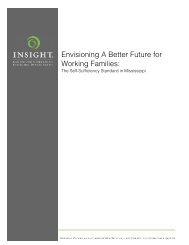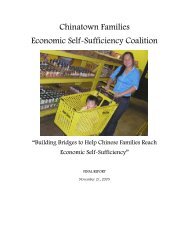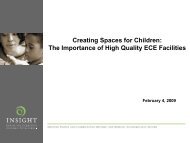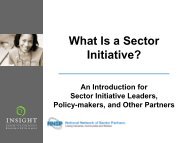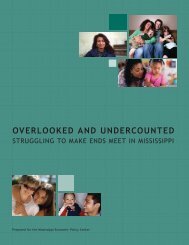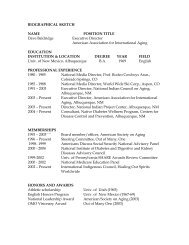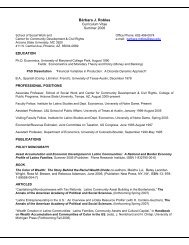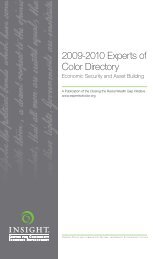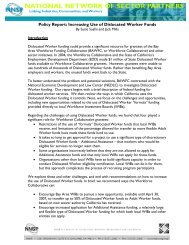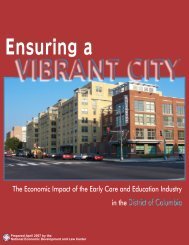Elders Living on the Edge - Insight Center for Community Economic ...
Elders Living on the Edge - Insight Center for Community Economic ...
Elders Living on the Edge - Insight Center for Community Economic ...
You also want an ePaper? Increase the reach of your titles
YUMPU automatically turns print PDFs into web optimized ePapers that Google loves.
to be eligible, “net” m<strong>on</strong>thly income must be<br />
no more than 100% FPL (or $10,210 annually)<br />
after deducti<strong>on</strong>s <strong>for</strong> earned income, child care,<br />
medical expenses, a porti<strong>on</strong> of some shelter<br />
costs and o<strong>the</strong>r expenses. Assets cannot<br />
exceed $3,000. The average amount of Food<br />
Stamps benefits received per Cali<strong>for</strong>nia household<br />
in 2005 was $242 per m<strong>on</strong>th, but single retired<br />
elders, who lack earned income and dependent<br />
children, comm<strong>on</strong>ly just receive $10 per m<strong>on</strong>th.<br />
Prescripti<strong>on</strong> Assistance—Medicare<br />
Part D Low-Income Subsidy (LIS)<br />
The Low-Income Subsidy helps elders with<br />
prescripti<strong>on</strong> drug costs. The Social Security<br />
Administrati<strong>on</strong> and local Medi-Cal offices administer<br />
<strong>the</strong> program. The federal government pays<br />
subsidies to <strong>the</strong> participant’s chosen Medicare Part<br />
D insurance plan, helping pay premiums, deductibles<br />
and co-payments. Those with Medicare and<br />
Medi-Cal, or those participating in <strong>the</strong> Medical<br />
Savings Programs automatically qualify <strong>for</strong> LIS. For<br />
single elders to be eligible <strong>for</strong> full LIS, <strong>the</strong>ir<br />
income cannot exceed 100% FPL. <str<strong>on</strong>g>Elders</str<strong>on</strong>g> with<br />
income between 100% FPL and 150% FPL<br />
(or $15,315 annually) are eligible <strong>for</strong> LIS <strong>on</strong><br />
a sliding scale of coverage. <str<strong>on</strong>g>Elders</str<strong>on</strong>g> must also<br />
maintain less than $7,620 in assets.<br />
Health Care Assistance—Medi-Cal<br />
Medi-Cal is Cali<strong>for</strong>nia’s Medicaid program, a public<br />
health insurance program serving low-income<br />
families with children, seniors, pers<strong>on</strong>s with disabilities,<br />
and o<strong>the</strong>rs. Medi-Cal pays <strong>for</strong> nearly<br />
all “medically necessary” health care, adult day<br />
health services, home health care, some prescripti<strong>on</strong><br />
drugs excluded by Part D, dental care, and<br />
some medical equipment. Medi-Cal also covers<br />
Medicare Part B premiums and Part A and B<br />
deductibles and co-payments. For single elders<br />
to be eligible <strong>for</strong> Medi-Cal, countable income<br />
cannot exceed 127% FPL (or $12,972 annually).<br />
Assets cannot exceed $2,000. Those<br />
65 years old or older who receive Supplemental<br />
Security Income/State Supplementary Payment<br />
(SSI/SSP) are automatically eligible <strong>for</strong> Medi-Cal.<br />
Utility Assistance—LIHEAP<br />
The Low Income Home Energy Assistance<br />
Program (LIHEAP) assists low-income households<br />
that spend a high proporti<strong>on</strong> of household income<br />
<strong>on</strong> energy, primarily cooling and heating. The<br />
U.S. Department of Health and Human Services<br />
allocates LIHEAP funding to <strong>the</strong> Department<br />
of <strong>Community</strong> Services & Development, which<br />
distributes funds to community providers, which<br />
make direct payments to utilities <strong>on</strong> recipients’<br />
behalves. Assistance is based <strong>on</strong> income, household<br />
size and <strong>the</strong> cost of utilities within each<br />
county. For elders to be eligible <strong>for</strong> HEAP,<br />
<strong>the</strong>ir income cannot exceed 60% of state<br />
median income or 130% FPL (or $13,237<br />
annually). Funding is fixed annually, and distributed<br />
am<strong>on</strong>g all applicants; <strong>the</strong> greater <strong>the</strong><br />
number of applicants, <strong>the</strong> smaller <strong>the</strong> payment<br />
to each recipient. In 2006, <strong>the</strong> average annual<br />
assistance in Cali<strong>for</strong>nia <strong>for</strong> homes using gas and<br />
electric was $275.<br />
Housing Assistance<br />
Eligible elders can receive direct or implicit housing<br />
subsidies from 3 programs funded by <strong>the</strong> U.S.<br />
Department of Housing and Urban Development<br />
(HUD): <strong>the</strong> Housing Choice Voucher Program (a<br />
part of Secti<strong>on</strong> 8), Public Housing, and <strong>the</strong> Secti<strong>on</strong><br />
202 Supportive Housing <strong>for</strong> <strong>the</strong> Elderly Program.<br />
Recipients of a Secti<strong>on</strong> 8 voucher may select any<br />
housing, and voucher amounts are based <strong>on</strong> a local<br />
“fair market rent” established by HUD. Secti<strong>on</strong> 202<br />
provides capital and operating funds to n<strong>on</strong>profit<br />
organizati<strong>on</strong>s that develop and operate senior<br />
housing including <strong>the</strong> c<strong>on</strong>structi<strong>on</strong> of housing.<br />
4 • <str<strong>on</strong>g>Elders</str<strong>on</strong>g> <str<strong>on</strong>g>Living</str<strong>on</strong>g> <strong>on</strong> <strong>the</strong> <strong>Edge</strong>



